
Messier 61 is an intermediate barred spiral galaxy in the Virgo Cluster of galaxies. It was first discovered by Barnaba Oriani on May 5, 1779, six days before Charles Messier discovered the same galaxy. Messier had observed it on the same night as Oriani but had mistaken it for a comet. Its distance has been estimated to be 45.61 million light years from the Milky Way Galaxy. It is a member of the M61 Group of galaxies, which is a member of the Virgo II Groups, a series of galaxies and galaxy clusters strung out from the southern edge of the Virgo Supercluster.
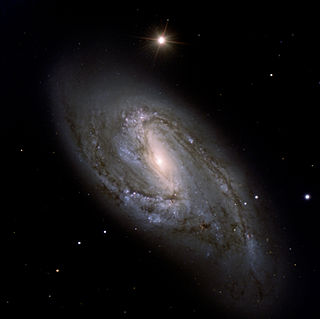
Messier 66 or M66, also known as NGC 3627, is an intermediate spiral galaxy in the southern, equatorial half of Leo. It was discovered by French astronomer Charles Messier on 1 March 1780, who described it as "very long and very faint". This galaxy is a member of a small group of galaxies that includes M65 and NGC 3628, known as the Leo Triplet or the M66 Group. M65 and M66 are a common object for amateur astronomic observation, being separated by only 20′.

NGC 2841 is an unbarred spiral galaxy in the northern circumpolar constellation of Ursa Major. It was discovered on 9 March, 1788 by German-born astronomer William Herschel. J. L. E. Dreyer, the author of the New General Catalogue, described it as, "very bright, large, very much extended 151°, very suddenly much brighter middle equal to 10th magnitude star". Initially thought to be about 30 million light-years distant, a 2001 Hubble Space Telescope survey of the galaxy's Cepheid variables determined its distance to be approximately 14.1 megaparsecs or 46 million light-years. The optical size of the galaxy is 8.1′ × 3.5′.
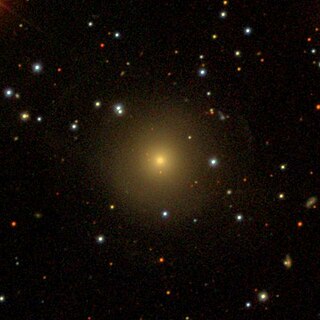
NGC 7315 is a lenticular galaxy in the constellation of Pegasus. It was discovered on 11 September 1872 by Édouard Stephan. It was described as "very faint, extremely small, round, brighter middle" by John Louis Emil Dreyer, the compiler of the New General Catalogue.
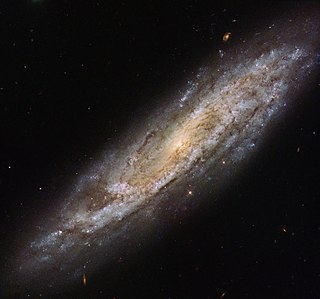
NGC 2770 is a spiral galaxy in the northern constellation of Lynx, near the northern constellation border with Cancer. It was discovered by German-born astronomer William Herschel on December 7, 1785. J. L. E. Dreyer described it as, "faint, large, much extended 150°, mottled but not resolved, 2 stars to north". NGC 2770 was the target for the first binocular image produced by the Large Binocular Telescope.

NGC 935 and IC 1801 are a pair of interacting galaxies within the Aries constellation. They were discovered on 18 September 1885 by Lewis Swift. NGC 935 is the northern member of the pair, and IC 1801 is the southern. Together, they are listed in Halton Arp's Atlas of Peculiar Galaxies as Arp 276, as an example of interacting galaxies.

NGC 5490 is a large elliptical galaxy located in the constellation of Boötes. Its velocity relative to the cosmic microwave background is 5,075 ± 22 km/s, which corresponds to a Hubble distance of 244.1 ± 17.1 Mly (74.85 ± 5.25 Mpc). In addition, 13 non-redshift measurements gives a distance of 269.98 ± 15.01 Mly (82.777 ± 4.603 Mpc). NGC 5490 was discovered by the German-British astronomer William Herschel on 14 March 1784.

Arp 271 is a pair of similarly sized interacting spiral galaxies, NGC 5426 and NGC 5427, in the constellation of Virgo. It is not certain whether the galaxies are going to eventually collide or not. They will continue interacting for tens of millions of years, creating new stars as a result of the mutual gravitational attraction between the galaxies, a pull seen in the bridge of stars already connecting the two. Located about 130 million light-years away, the Arp 271 pair is about 130,000 light-years across. It was originally discovered in 1785 by William Herschel. It is speculated, that the Milky Way will undergo a similar collision in about five billion years with the neighbouring Andromeda Galaxy, which is currently located about 2.6 million light-years away.

NGC 7714 is a spiral galaxy in the constellation Pisces. Its velocity with respect to the cosmic microwave background is 2430 ± 26 km/s, which corresponds to a Hubble distance of 116.9 ± 8.3 Mly (35.85 ± 2.54 Mpc). In addition, five non-redshift measurements give a distance of 92.24 ± 8.69 Mly (28.280 ± 2.664 Mpc). It was discovered by British astronomer John Herschel on 18 September 1830.

NGC 3938 is an unbarred spiral galaxy in the Ursa Major constellation. It was discovered on 6 February 1788 by William Herschel. It is one of the brightest spiral galaxies in the Ursa Major South galaxy group and is roughly 67,000 light years in diameter. It is approximately 43 million light years away from Earth. NGC 3938 is classified as type Sc under the Hubble sequence, a loosely wound spiral galaxy with a smaller and dimmer bulge. The spiral arms of the galaxy contain many areas of ionized atomic hydrogen gas, more so towards the center.

NGC 5668 is a nearly face-on spiral galaxy, visual magnitude about 11.5, located about 81 million light years away in the constellation Virgo. It was discovered on 29 April 1786 by William Herschel.

NGC 4527 is a spiral galaxy in the constellation Virgo. It was discovered by German-British astronomer William Herschel on 23 February 1784.

NGC 1084 is an unbarred spiral galaxy in the constellation Eridanus. It is located at a distance of about 63 million light-years away from the Milky Way. The galaxy was discovered by William Herschel on 10 January 1785. It has multiple spiral arms, which are not well defined. It belongs in the same galaxy group with NGC 988, NGC 991, NGC 1022, NGC 1035, NGC 1042, NGC 1047, NGC 1052 and NGC 1110. This group is in turn associated with the Messier 77 group.
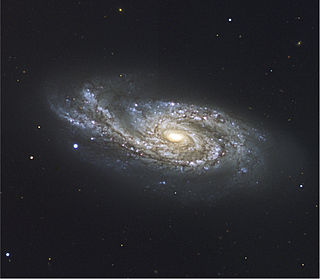
NGC 908 is an unbarred spiral galaxy in the constellation Cetus. It was discovered on 20 September 1786 by William Herschel. This galaxy is 56 million light years away from Earth. It is the main galaxy in the NGC 908 group, which also includes NGC 899, NGC 907, and IC 223.
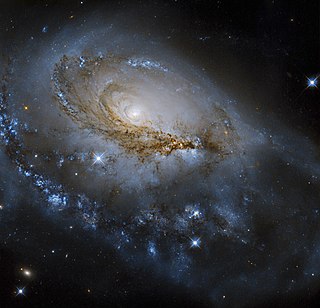
NGC 1961 is a spiral galaxy in the constellation Camelopardalis. It was discovered by William Herschel on 3 December 1788. It is at a distance of about 200 million light years from Earth, which, given its apparent dimensions, means that NGC 1961 is more than 220,000 light years across.

NGC 521, also occasionally referred to as PGC 5190 or UGC 962, is a barred spiral galaxy located approximately 224 million light-years from the Solar System in the constellation Cetus. It was discovered on 8 October 1785 by astronomer William Herschel.
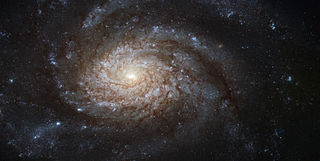
NGC 3810 is a spiral galaxy located in the constellation Leo. It is about 50 million light years from Earth, and estimated to be about 60,000 light years in diameter. William Herschel discovered it on 15 March 1784.
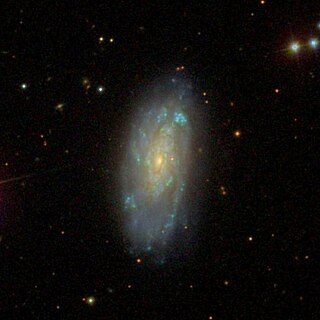
NGC 7448 is a spiral galaxy located in the constellation Pegasus. It is located at a distance of circa 80 million light years from Earth, which, given its apparent dimensions, means that NGC 7448 is about 60,000 light years across. It was discovered by William Herschel on October 16, 1784. It is included in the Atlas of Peculiar Galaxies in the category galaxies with detached segments.

NGC 3947 is a barred spiral galaxy in the constellation of Leo. Its velocity with respect to the cosmic microwave background is 6528 ± 23 km/s, which corresponds to a Hubble distance of 314.0 ± 22.0 Mly (96.28 ± 6.75 Mpc). In addition, three non redshift measurements give a distance of 284.67 ± 12.90 Mly (87.28 ± 3.956 Mpc). It was discovered by German-British astronomer William Herschel on 26 April 1785.

NGC 664 is a spiral galaxy in the constellation of Pisces. Its velocity with respect to the cosmic microwave background is 5137 ± 21 km/s, which corresponds to a Hubble distance of 247.1 ± 17.3 Mly (75.77 ± 5.31 Mpc). In addition, six non redshift measurements give a distance of 218.91 ± 3.66 Mly (67.117 ± 1.123 Mpc). It was discovered by British astronomer John Herschel on 24 September 1830.




















